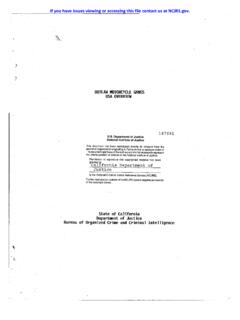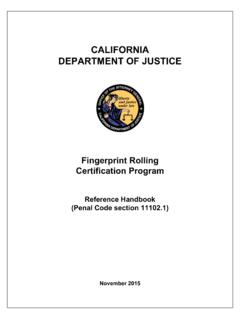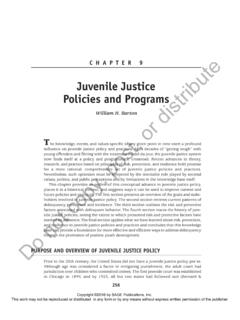Transcription of A Guide for Law Enforcement - Office of Justice Programs
1 Department of JusticeOffice of Justice ProgramsNational Institute of Justice DEPARTMENTOFJUSTICE OFFICEOFJUSTICEPROGRAMSBJANIJOJJDPBJSOVC E yewitness EvidenceA Guide for Law Enforcementresearch Department of JusticeOffice of Justice Programs810 Seventh Street , DC 20531 Janet RenoAttorney GeneralRaymond C. FisherAssociate Attorney GeneralLaurie RobinsonAssistant Attorney GeneralNo l BrennanDeputy Assistant Attorney GeneralJeremy TravisDirector, National Institute of JusticeDepartment of Justice Response Center800 421 6770 Office of Justice ProgramsNational Institute of JusticeWorld Wide Web SiteWorld Wide Web and Approved by theTechnical Working Group for Eyewitness EvidenceOctober 1999A Guide for Law EnforcementEyewitness Department of JusticeOffice of Justice ProgramsNational Institute of JusticeJeremy Travis, M.
2 Rau, MonitorThis document is not intended to create, does not create, and may not berelied upon to create any rights, substantive or procedural, enforceable atlaw by any party in any matter civil or or points of view expressed in this document represent aconsensus of the authors and do not necessarily reflect the officialposition of the Department of 178240 The National Institute of Justice is a component of the Office of Jus-tice Programs , which also includes the Bureau of Justice Assistance,the Bureau of Justice Statistics, the Office of Juvenile Justice andDelinquency Prevention, and the Office for Victims of From the Attorney GeneralEyewitnesses frequently play a vital role in uncovering the truthabout a crime. The evidence they provide can be critical in identi-fying, charging, and ultimately convicting suspected criminals.
3 That iswhy it is absolutely essential that eyewitness evidence be accurate andreliable. One way of ensuring we, as investigators, obtain the mostaccurate and reliable evidence from eyewitnesses is to follow soundprotocols in our cases in which DNA evidence has been used to exonerate indi-viduals convicted primarily on the basis of eyewitness testimony haveshown us that eyewitness evidence is not infallible. Even the most honestand objective people can make mistakes in recalling and interpreting awitnessed event; it is the nature of human memory. This issue has been atthe heart of a growing body of research in the field of eyewitness identifi-cation over the past decade. The National Institute of Justice conveneda technical working group of law Enforcement and legal practitioners,together with these researchers, to explore the development of improvedprocedures for the collection and preservation of eyewitness evidencewithin the criminal Justice Guide was produced with the dedicated and enthusiastic participa-tion of the seasoned professionals who served on the Technical WorkingGroup for Eyewitness Evidence.
4 These 34 individuals brought togetherknowledge and practical experience from jurisdictions large and smallacross the United States and Canada. I applaud their effort to worktogether over the course of a year in developing this consensus of recom-mended practices for law developing its eyewitness evidence procedures, every jurisdictionshould give careful consideration to the recommendations in this Guideand to its own unique local conditions and logistical factors that vary among investigations, including the nature andquality of other evidence and whether a witness is also a victim of theivcrime, may call for different approaches or even preclude the use ofcertain procedures described in the Guide , consideration of the Guide srecommendations may be invaluable to a jurisdiction shaping its ownprotocols.
5 As such, Eyewitness Evidence: A Guide for Law Enforcementis an important tool for refining investigative practices dealing with thisevidence as we continue our search for RenovTechnical Working Group for Eyewitness EvidenceThe Technical Working Group for Eyewitness Evidence(TWGEYEE) is a multidisciplinary group of content-area expertsfrom across the United States and Canada, from both urban and ruraljurisdictions, each representing his or her respective agency or of these individuals is experienced in the use of eyewitness evi-dence in the criminal Justice system from the standpoints of law enforce-ment, prosecution, defense, or social the outset of the TWGEYEE effort, the National Institute of Justice (NIJ) created a Planning Panel composed of distinguished law enforce-ment, legal, and research professionals to define needs, develop initialstrategies, and steer the larger group.
6 Additional members of the Techni-cal Working Group then were selected from recommendations solicitedfrom the Planning Panel, NIJ s regional National Law Enforcement andCorrections Technology Centers, and national organizations, includingthe National Sheriffs Association, the International Association of Chiefsof Police, the National District Attorneys Association, the NationalAssociation of Criminal Defense Lawyers, and the National Legal Aid &Defender , over a 1-year period, the 34 members of TWGEYEE listedbelow worked together to develop this handbook, Eyewitness Evidence:A Guide for Law PanelComdr. Ella M. Bully (Ret.)Detroit Police DepartmentDetroit, MichiganSgt. Paul Carroll (Ret.)Chicago Police DepartmentChicago, IllinoisCarole E.
7 Chaski, for LinguisticEvidenceGeorgetown, DelawareJames DoyleAttorney at LawBoston, MassachusettsRonald P. Fisher, InternationalUniversityNorth Miami, FloridaMark R. LarsonKing County Prosecutor sOfficeSeattle, WashingtonCapt. Donald MauroLos Angeles County Sheriff sOfficeLos Angeles, CaliforniaMelissa MourgesNew York County DistrictAttorney s OfficeNew York, New YorkGary L. Wells, State UniversityAmes, IowaviTWGEYEE MembersNortheastMichael J. BarrasseLackawanna County DistrictAttorneyScranton, PennsylvaniaDet. Sgt. Chet BushKent County Sheriff s OfficeGrand Rapids, MichiganSolomon M. Fulero, , CollegeDayton, OhioDavid C. NiblackAttorney at LawWashington, Lt. Kenneth A. PatenaudeNorthampton PoliceDepartmentNorthampton, MassachusettsPatricia RamirezDodge County DistrictAttorneyJuneau, WisconsinSenior InvestigatorEugene RifenburgNew York State Police (Ret.)
8 Oneida Indian Nation PoliceMunnsville, New YorkDet. Edward RusticusKent County Sheriff s OfficeGrand Rapids, MichiganCapt. Michael B. WallNorthampton PoliceDepartmentNorthampton, MassachusettsSoutheastDeputy Daniel Alarcon IIHillsborough County Sheriff sOfficeTampa, FloridaFirst Sgt. Roger BroadbentVirginia State PoliceFairfax Station, VirginiaCpl. BurtonHillsborough County Sheriff sOfficeTampa, FloridaCaterina DiTragliaState of MissouriPublic Defender SystemSt. Louis, MissouriOfficer Patricia MarshallChicago Police DepartmentChicago, IllinoisDet. Ray StaleyKansas City Police DepartmentKansas City, MissouriLt. Tami ThomasAtlantic Beach PoliceDepartmentAtlantic Beach, North CarolinaRocky MountainDet. Sgt. J. Glenn Diviney (Ret.)Tarrant County Sheriff sOfficeFort Worth, TexasInvestigations Chief ArlynGreydanusMontana Department ofJusticeDivision of CriminalInvestigationHelena, MontanaInvestigator Kathy GriffinLoveland Police DepartmentLoveland, ColoradoRoy S.
9 Malpass, of Texas at El PasoEl Paso, TexasJeralyn MerrittAttorney at LawDenver, ColoradoWestJames FoxSan Mateo County DistrictAttorneyRedwood City, CaliforniaWilliam HodgmanLos Angeles County DistrictAttorney s OfficeLos Angeles, CaliforniaCanadaRod Lindsay, s UniversityKingston, OntarioJohn Turtle, Polytechnic UniversityToronto, OntarioviiAcknowledgmentsThe National Institute of Justice (NIJ) acknowledges with greatthanks the members of the Technical Working Group for EyewitnessEvidence (TWGEYEE) for their extensive efforts on this project and theirdedication to improving the use of eyewitness evidence in the criminaljustice system. All of the 34 members of this network of experts gavetheir time and expertise to draft and review the Guide , providing feedbackand perspectives from a variety of disciplines and from all areas of theUnited States as well as Canada.
10 The true strength of this Guide isderived from their commitment to develop procedures that could beimplemented across the Nation, from small, rural townships to large,metropolitan areas. In addition, thanks are extended to the agencies andorganizations represented by the Technical Working Group members fortheir flexibility and support, which enabled the participants to see thisproject through to is grateful to all the individuals from various national organizationsacross the Nation who responded to the request for nominations of expertsin the field of eyewitness evidence to serve on TWGEYEE. It was fromtheir recommendations that the members were selected. In particular,thanks are extended to James D. Polley IV of the National District AttorneysAssociation, Daniel Rosenblatt of the International Association of Chiefsof Police, Stuart Statler of the National Association of Criminal DefenseLawyers, Clinton Lyons of the National Legal Aid & Defender Association,and Aldine N.














